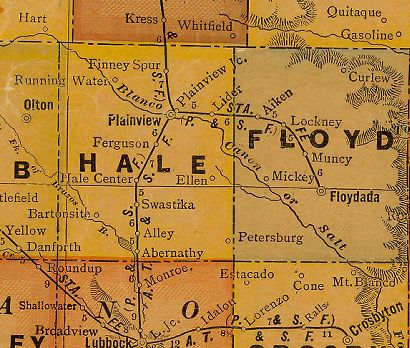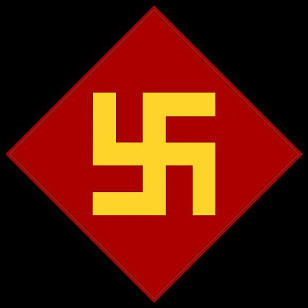|
|
 |
History
in a Pecan Shell
Swastika, perhaps
due to the name's association with the Nazis, has been removed from
even the most detailed county maps. It first appeared on the General
Land Office 1920s map of Hale
County and remained for both the 1930 Highway map and the 1940
state county map. It thereafter disappeared, with not so much as a
cemetery shown for the town’s presence.
The Swastika, one of the most widely used symbols of good luck, has
wide-ranging religious significance as well. The name is from the
Sanskrit and it has appeared on inscriptions, carvings, jewelry and
at least one vegetarian barbeque
sauce can. It was a talisman for early aviators and Charles Lindbergh
had it painted on the Spirit of St Louis. Texas
Guinan’s boyfriend used it as a logo on the doors of his fleet
of taxis in 1920s NYC and it even appeared on a unit
patch for the U.S. Army’s 45th Infantry Division.
But after the Nazis appropriated it for their political party, it
fell out of favor. A history of the town may be available for a researcher
in the Hale County
area, but currently, there’s no content available for our coverage.
Just the appearance on the old county maps. |
 |
U.S.
Army’s 45th Infantry Insignia
Courtesy Wikipedia Commons |
Subject: Swastika,
Texas
The swastika
or 'sun wheel' is a sacred symbol among American Indians. That's
why the 45th Infantry--the Oklahoma National Guard--used it
as their patch. It was replaced by a stylized thurnderbird. It was
featured on the rosette of the warbonnet of the 'Screaming Sioux,'
which was the squadron emblem for the Lafayette Escadrille, made up
of volunteer Americans who flew for the French (it was actually the
air arm of the French Foreign Legion) during WW
I. It was also, prior to WW
II, used widely by the Boy Scouts in the US, but not overseas.
Today it is illegal to display a swastika in most of Europe.
During WW II,
fighter pilots in Europe painted small swastikas on their planes--one
for each German plane shot down. Bomber pilots often painted small
swastikas on their planes for each mission flown. Scale models of
those aircraft, today, are marketed all over the world. Instead of
swastikas, the decal 'score marks' are usually small yellow crosses
on those models. However, on models of planes from the Pacific the
decals are accurate--representations of Japan's 'rising sun' flag.
Captain Bong's P-38 had 50 rising suns on it. He was the highest-scoring
ace in US history. He was brought back to the States to train pilots
and was killed when a P-80 Shooting Star, the first US operational
jet fighter, flamed out on takeoff. He was testing the new aircraft.
- C.
F. Eckhardt, May 05, 2010 |
 |
Swastika
on Vegetarian Barbecue Sauce
TE photo |
"Sign
of Good Coal"
Courtesy Texas State Library and Archives |
1940s
Hale County map showing
Swastika
From Texas state map #4335
Courtesy Texas General Land Office |
Swastika, Texas
Forum
Subject:
"Swastika", Texas
There has never been a community at or near the "Swastika" on this
map. My best guess is that it is simply a named switch on the railroad.
It's probably at the point where the Cone grain elevator stands, about
five miles south of Hale
Center. Further evidence is that no roads are shown, only railroads.
And there are no towns of "Alley" or "Ferguson", either. I know from
growing up in the area that "Ferguson" was a railroad switch, probably
at the "Six Point" elevator north of Hale
Center. - Dean Brown, Canyon,
Texas, February 13, 2017 |
|
Texas
Escapes,
in its purpose to preserve historic, endangered and vanishing Texas,
asks that anyone wishing to share their local history, stories and
recent/vintage/historic photos, please contact
us.
|
|
|

 Texas
Gulf Coast
Texas
Gulf Coast East
Texas
East
Texas Central
Texas North
Central
Texas North Central
Texas South
Central
Texas South Texas
Panhandle
Texas
Panhandle South
Texas
South
Texas Texas
Hill Country
Texas
Hill Country West
Texas
West
Texas Texas
Ghost Towns
Texas
Ghost Towns Texas
Counties
Texas
Counties